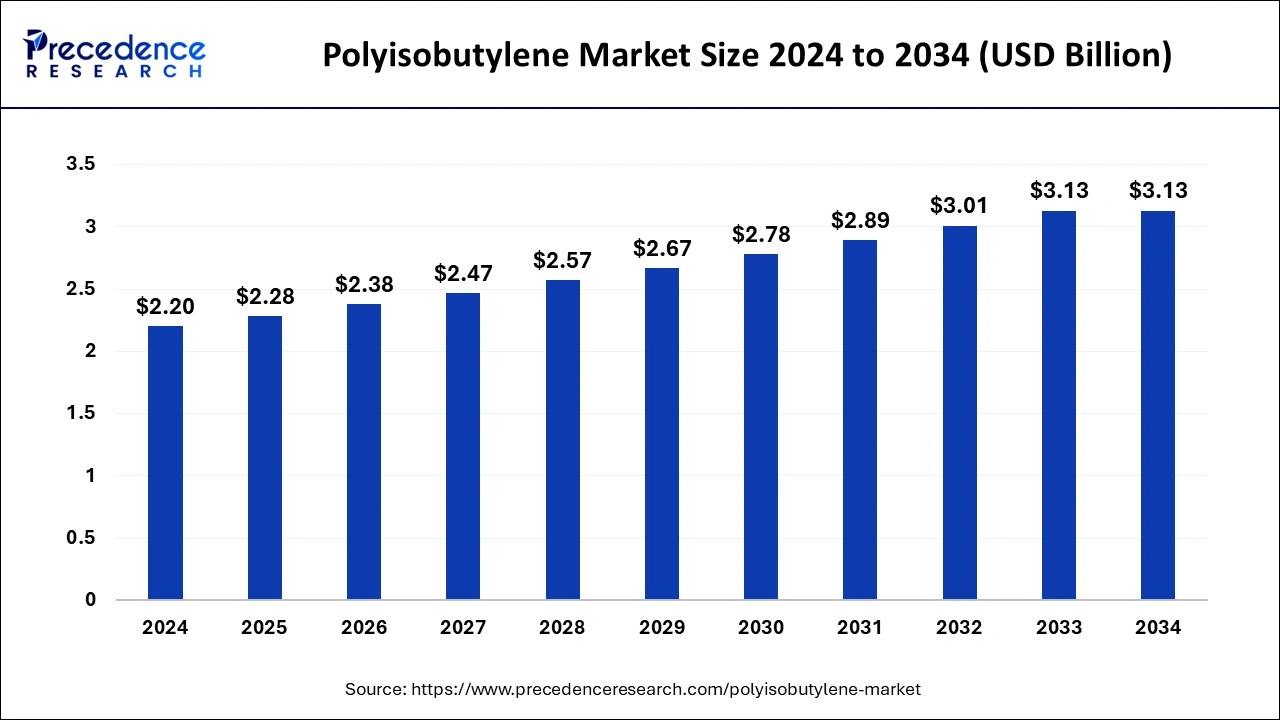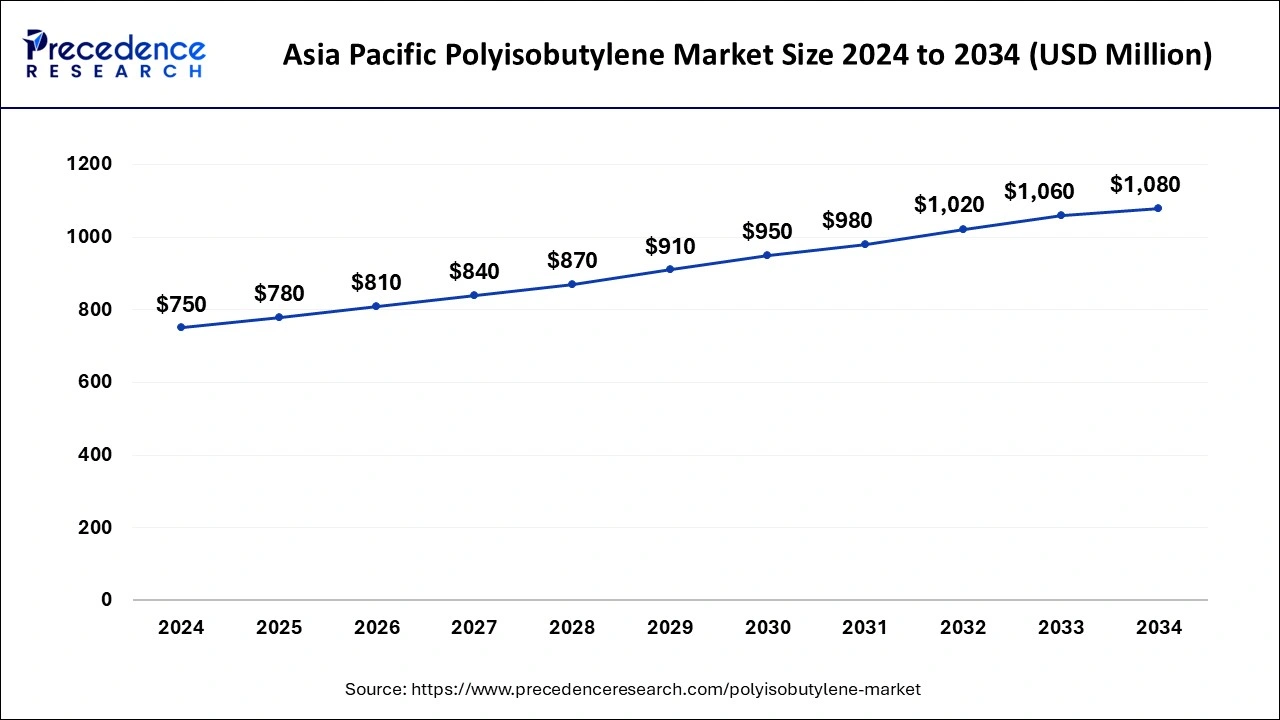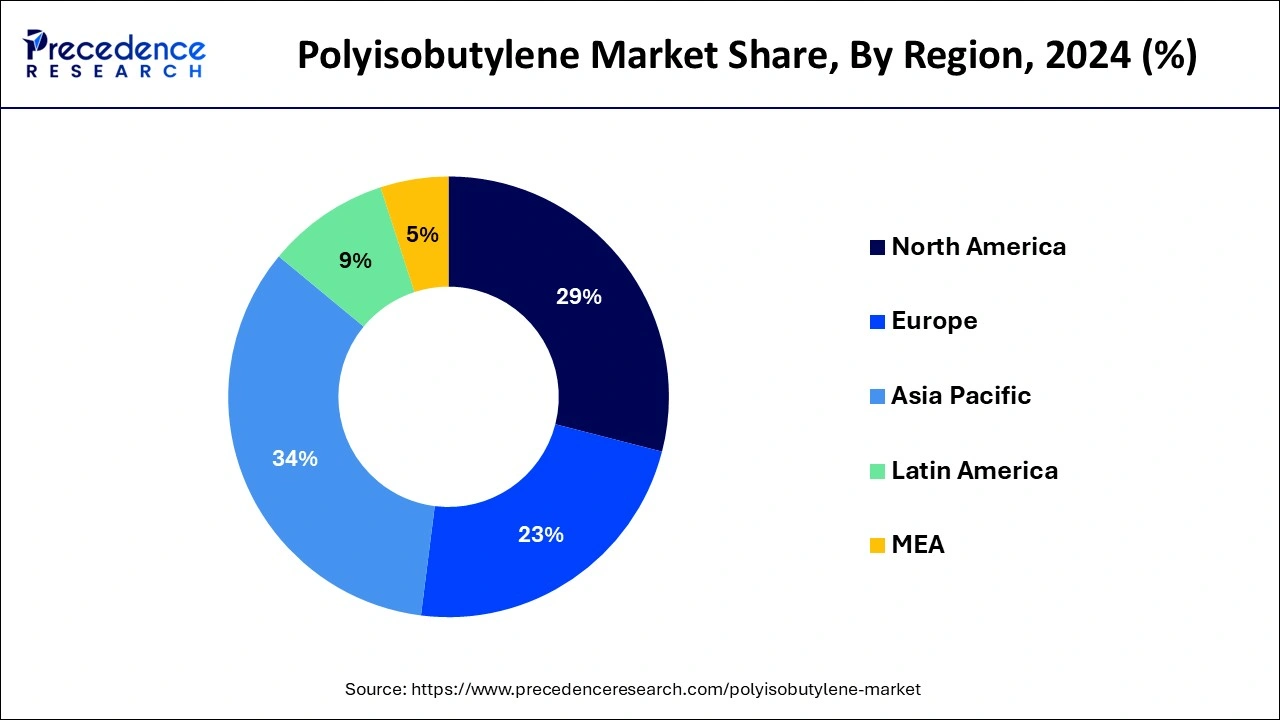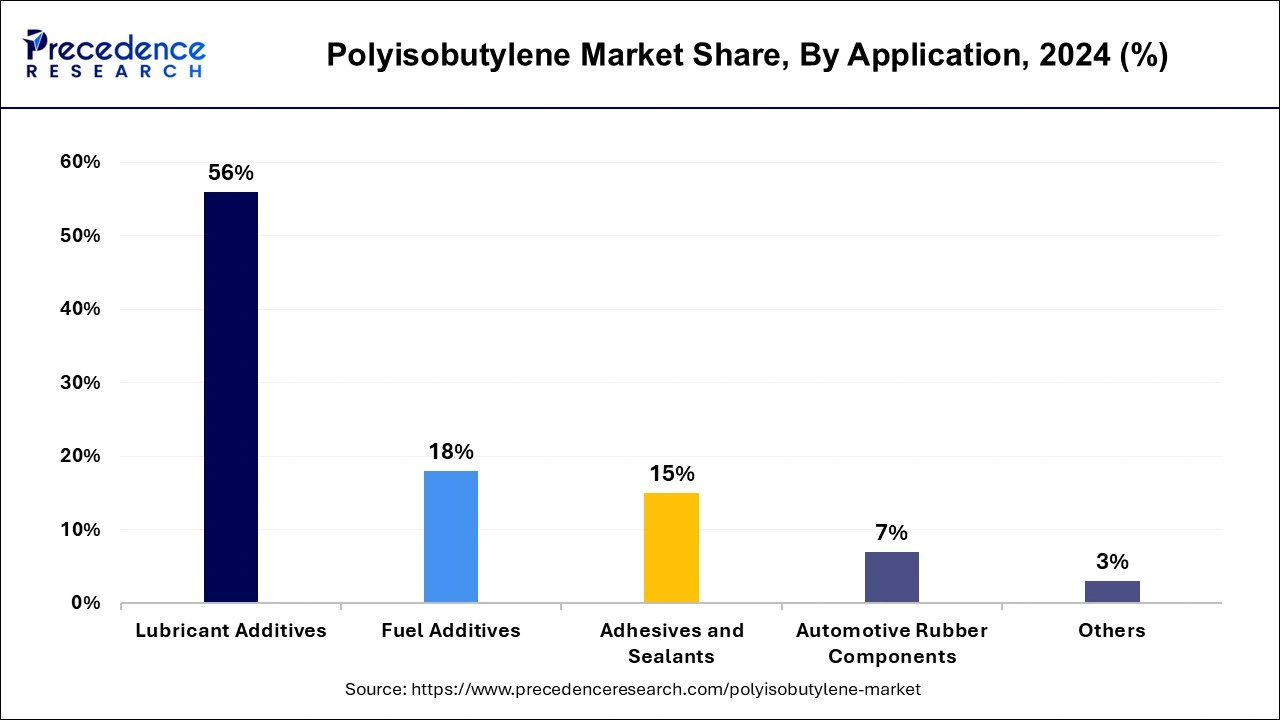Polyisobutylene Market Size and Forecast 2025 to 2034
The global polyisobutylene market size accounted for USD 2.20 billion in 2024 and is predicted to increase from USD 2.28 billion in 2025 to approximately USD 3.13 billion by 2034, expanding at a CAGR of 3.59% from 2025 to 2034. The rising demand of polyisobutylene in automotive sector along with food, chemical, industrial, construction, transportation, medical, andcosmetics industry are responsible for growth in the market.

Polyisobutylene Market Key Takeaways
- The global polyisobutylene market was valued at USD 2.20 billion in 2024.
- It is projected to reach USD 3.13 billion by 2034.
- The market is expected to grow at a CAGR of 3.59% from 2025 to 2034.
- Asia Pacific dominated the market with the largest market share of 34% in 2024.
- North America is the fastest growing region and is expected to grow significantly in the forecast period.
- By product, the high molecular weight polyisobutylene segment has held the major market of 66% in 2024.
- By product, medium molecular weight polyisobutylene segment is the fastest growing segment and is expected to grow significantly in the forecast period.
- By application, the lubricant additives segment has contributed more than 56% of market share in 2024.
- By application, the automobile industry segment is the fastest growing segment and is expected to grow continuously in the forecast period.
Asia PacificPolyisobutylene Market Size and Growth 2025 to 2034
The Asia Pacific polyisobutylene market size was exhibited at USD 750 million in 2024 and is projected to be worth around USD 1,080 million by 2034, growing at a CAGR of 3.71% from 2025 to 2034.

Asia Pacific dominated the polyisobutylene market in 2024 and the region is observed to sustain the position during the forecast period. The reason behind the growth of the Asia Pacific region for polyisobutylene industry is mainly the high demand from various key industries, including automotive, construction, cosmetics, and aerospace, in developing countries such as China and India. Major tire manufacturers in the region are trying to develop and launch advanced products such as tubeless tires for ease to use and replace.
Additionally, the increasing trend of adopting electric vehicles is expected to drive the demand of tubeless tires which gradually reduce the maintenance procedures. Moreover, the increasing automotive production and advancements of automotive industry in Asian countries are contributing their efforts in driving the polyisobutylene market.

North America is the fastest growing region and is expected to grow significantly during the forecast period. The main reason behind the growth of the region is due to strong industrial and automobile sectors. Significant manufacturers of the automotive sector in the region are significantly investing in production of tires, lubricants, and additives. The expansion of industrial practices in the region is propelled by urbanization. Additionally, increasing disposable income of people forces them to adopt more advanced technologies. All these factors are substantial in expanding the growth of the polyisobutylene market and is expected to grow significantly.
Market Overview
Polyisobutylene is an elastomer or synthetic rubber made up of polyisoprene. Polyisobutylene has a property to hold air so used to make things like the inner tubes, liner layers of tires, and the inner liners of basketballs. Due to increase in industrial production and investments, it is used mainly for lubricating additives. Also, used in various other industries including transportation, cosmetics and food divisions.
Governments are making stringent regulations due to environmental awareness and limiting its harmful impact on marine and aquatic life and hindering the import and export of polyisobutylene. Some attractive properties of these chemicals include resistance to corrosion, stable oxidation, high thickening efficiency, and low electrical conductivity. With the increasing demand for frozen foods, the attractive and sturdy packaging is also experiencing growth and necessary to maintain controlled temperature conditions for storage and transportation purposes. Growing consumption of packaged and canned food is driving the growth of polyisobutylene chemicals. Further, the major market key players are trying to invest more on lot of investments in research and development practices to expand the production which boost the growth in the polyisobutylene market over the forecast period.
Polyisobutylene Market Growth Factors
- Increasing industrial production and investments, adoption of polyisobutylene which is mainly used for lubricating additives propels the market.
- Some attractive properties of polyisobutylene include resistance to corrosion, stable oxidation, high thickening efficiency, and low electrical conductivity, which makes it favorable for different industries and hence, propels the polyisobutylene market.
- Polyisobutylene is used exclusively in automotive industry to make inner tubes and tires of different vehicles such as bus, car, airplane, and trucks which increases the growth of the market.
- Developing markets of different regions worldwide due to their increasing industrial production is driving the demand of polyisobutylene products. Hence, uplift the polyisobutylene market.
- The increasing demand of lubricant additives can positively affect the growth for adoption of more lubricants in different products globally and hence boost the polyisobutylene market.
- The key market players and manufacturers are trying to collaborate for the development of advanced technologies which gradually boost the polyisobutylene market.
Market Scope
| Report Coverage | Details |
| Market Size in 2025 | USD 2.28 Billion |
| Market Size in 2024 | USD 2.20 Billion |
| Market Size by 2034 | USD 3.13 Billion |
| Growth Rate from 2025 to 2034 | CAGR of 3.59% |
| Largest Market | Asia Pacific |
| Base Year | 2024 |
| Forecast Period | 2025 to 2034 |
| Segments Covered | Product and Application |
| Regions Covered | North America, Europe, Asia-Pacific, Latin America, and Middle East & Africa |
Market Dynamics
Driver
Rising demand of polyisobutylene in automotive sector
The automobile industry is the main sector for driving the use of fuel additives. The share for automobiles has always been significantly higher than that of any other fuel additives industry. The growing demand is due to the increasing middle-class income and lack of efficient fossil fuel alternatives. Derivatives of polyisobutylene like PIBSAs (polyisobutylene succinic anhydrides) and the corresponding PIBSIs (polyisobutylene succinic imides) are one of the most widely used additives in automotive applications specially to meet the rising demands of engine oils and improve their working performance.
In the automotive industry, polyisobutylene is used to make inner tubes and tires of different vehicles such as buses, cars, airplane, and trucks. All these factors are responsible for increasing demand among consumers and boosting the polyisobutylene market.
Restraint
Harmful impact on environment due to polyisobutylene
Polyisobutylene is extensively used in many industries as a sealant, lubricant, additives, etc. mainly used in the automotive sector to increase engine performance. Along with its beneficial properties it can also cause harm to the environment because it is a non-biodegradable product. If leaked or spilled in environment accidentally, degrade the environment as it becomes sticky as soon as comes in contact with water. The harmful effects of this chemical limit their usage in various industries. Further, the demand of consumers gradually decreases and hence, hampers the polyisobutylene market.
- For instance, new maritime laws banned the discharge of polyisobutylene at sea that affected more than 4,000 birds of at least 18 species. The birds were found dead or were affected by a sticky substance. After that the UK government's Maritime and Coastguard Agency (MCA) confirmed that the chemical that affected a huge number of bird species was polyisobutylene. It was flushed in water during the cleaning of ship tanks to improve engine performance.
Opportunity
Increasing emphasis on advanced technologies
The increase in launching of advanced technologies in various industries plays a vital role in the development of polyisobutylene products in order to enhance biocompatibility. Likely, automotive sector is more attentive towards production of tubeless tires instead of traditional tires. Tubeless tires are having ability to hold air for longer time so becoming popular among consumers. The use of polyisobutylene in automotive vehicles promotes slow release of air from tires and working of vehicles with a low pressure on tires.
Additionally, the key market players and manufacturers are trying to collaborate on the development of advanced tubeless tire technologies to reduce maintenance further results in driving the demand of polyisobutylene globally during the forecast period. These advancements also provide an innovative approach for driving the polyisobutylene market.
Product Insights
The high molecular weight polyisobutylene segment dominated the market with the largest share in 2024. Polyisobutylene is segmented into different molecular weight segments on the basis of molecular weight range. High molecular weight polyisobutylene is a solid, transparent rubber-like substance having high molecular weight and viscosity. It helps in maintaining high elasticity and resilient properties of polyisobutylene products. Due to its beneficial properties, it is extensively used in a wide range of applications, such as sealant, lubricants, and adhesives in the industrial, transportation, cosmetics and food divisions. Hence, the increasing demand of high weight polyisobutylene drives the polyisobutylene market.
Medium molecular weight polyisobutylene segment is the fastest growing segment and is expected to grow significantly in the forecast period. It is most commonly used in adhesives to maintain the tackiness and plasticizing properties. Medium molecular weight polyisobutylene is used mainly for food and beverage packaging due to its attractive properties such as hydrophobic stability, antibacterial nature, and adhesive nature. Along with this, it also helps in maintaining the safety of food products. All these factors can be able to increase demand of medium molecular weight polyisobutylene and is expected to boost the polyisobutylene market over the forecast period.
Application Insights
The lubricant additives segment led the polyisobutylene market in 2024. Developing markets in regions such as Asia Pacific due to the increasing industrial production is driving the demand of industrial oil products. Polyisobutylene based lubricant additive is an important aspect for improving the quality and performance of oil to be used in automotive and other industrial applications. The growth in this segment can be attributed due to the large consumption of industrial lubricants in various sectors including chemical and mining industries. Due to which the demand for industrial lubricants in applications, such as hydraulics, industrial engines, centrifuges, compressors, and bearings gradually increases. This increasing demand of lubricant additives can positively affect the growth for adoption of more lubricants in different products globally and hence boost the polyisobutylene market.

Along with this, the automobile industry segment is the fastest growing segment and is expected to grow continuously in the forecast period. The rising demand for passenger and commercial vehicles for private and public transportations use is the reason for growth of the automotive industry. Moreover, the growing e-commerce and logistics industry globally is expected to drive the adoption of commercial vehicles for delivering products. Polyisobutylene is used as an additive in engine fuel of automotives to prevent sludge and other deposits on engine that can degrade the working performance of vehicles. All these factors are expected to increase the demand of additives and lubricants, thereby supporting the growth in usage of polyisobutylene lubricants. Hence, it is expected to drive the polyisobutylene market in the forecast period.
Recent Developments
- In Aug 2023, BASF announced its plans to increase the production rate of medium molecular weight polyisobutylene. As an outcome, the rise in demand of polyisobutylene is experienced globally.
- In Aug 2022, Quanex announced the launching of new moisture protectant for solar panels that can be useful for manufacturers to apply during the final manufacturing process.
Polyisobutylene Market Companies
- BASF SE
- Daelim Co., Ltd.
- TPC Group
- INEOS
- Kothari Petrochemicals
- Braskem
- ENEOS Corporation
- Zhejiang Shunda New Material Co., Ltd.
- Shandong Hongrui New Material Technology Co., Ltd.
Segments Covered in the Report
By Product
- High Molecular Weight
- Medium Molecular Weight
- Low Molecular Weight
By Application
- Adhesives & Sealants
- Automotive Rubber Components
- Fuel Additives
- Lubricant Additives
- Others
By Geography
- North America
- Asia Pacific
- Europe
- Latin America
- Middle East & Africa
For inquiries regarding discounts, bulk purchases, or customization requests, please contact us at sales@precedenceresearch.com
Frequently Asked Questions
Ask For Sample
No cookie-cutter, only authentic analysis – take the 1st step to become a Precedence Research client
 sales@precedenceresearch.com
sales@precedenceresearch.com
 +1 804-441-9344
+1 804-441-9344